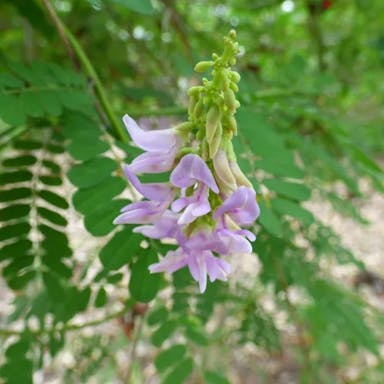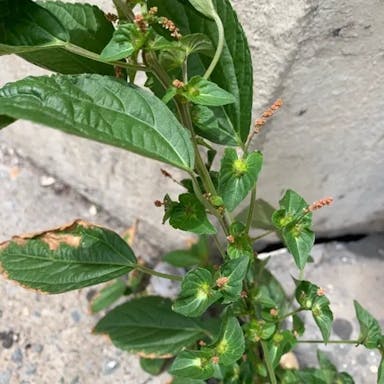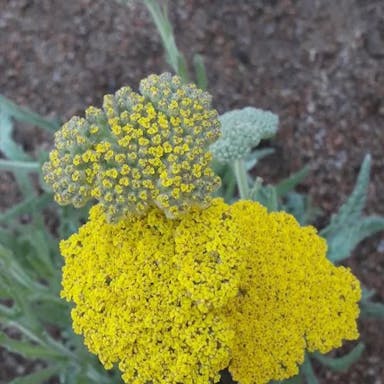American fox sedge, also known as Carex vulpinoidea, is a plant species that belongs to the sedge family, Cyperaceae. It is native to North America and can be found in various habitats, including wet meadows, marshes, and stream banks. This perennial plant has a clumping growth habit and can reach a height of 2 to 4 feet. The flowers of Carex vulpinoidea are small and inconspicuous, arranged in dense clusters called spikes. The spikes are typically greenish-brown in color and appear in late spring to early summer. The plant produces fruits in the form of small, brownish nutlets. Carex vulpinoidea is a hardy plant that is relatively easy to cultivate. It prefers moist to wet soil and can tolerate both full sun and partial shade. It is often used in wetland restoration projects and can help stabilize soil in areas prone to erosion. There are several varieties of Carex vulpinoidea, including 'Ivory Sedge' and 'Variegata', which have variegated foliage. These varieties add visual interest to gardens and landscapes. In conclusion, Carex vulpinoidea, or American fox sedge, is a native North American plant with clumping growth, greenish-brown spikes, and small nutlet fruits. It is a hardy plant that prefers moist to wet soil. Varieties with variegated foliage are available for aesthetic purposes.
American fox sedge
- Scientific name
- Carex vulpinoidea
Basic Information
- Cyperaceae Family Carex Genus American fox sedge Species
- Cyperaceae > Carex > Carex vulpinoidea
- 83%
- The Completeness of This Encyclopedia
Please help us complete the encyclopedia, Terrarium is a encyclopedia service to be completed with everyone in the world. Currently, this page is 83% complete. For more information on how to contribute, please click here.
- Forb/herb
- Graminoid
- Height
- 60cm ~ 100cm
- Flower Color
- Leaf Color
- Anthesis
- spring, summer
- Sunlight Exposure
Full Sun Long hours of sunlight from morning to afternoon Partial Shade A location in the shade of a tree or where either the morning or afternoon is shaded Full Shade A place where there is no direct sunlight
- Full Sun
- Hardiness Zones
This is an indicator to know to which zone each plant can winter. Knowing the zone of each plant gives you an idea of the cold temperature resistance when grown in the ground without a roof. 2: -42.7 to -40.0 3: -39.9 to -34.4 4: -34.3 to -28.9 5: -28.8 to -23.3 6: -23.2 to -17.8 7: -17.7 to -12.2 8: -12.1 to -6.7 9: -6.6 to -1.1 10: -1.0 to 4.4 11: 4.5 to 10.0
- 3-8
- Cold resistance
- Excellent
- Heat resistance
- Fair
- Habitat of origin
- North America
- Growth Rate
- Normal
What is American fox sedge (Carex vulpinoidea)?
What is American fox sedge (Carex vulpinoidea)
Flower meaning
The American fox sedge, also known as Carex vulpinoidea, does not have a specific flower language commonly used in America. The language of flowers is a symbolic way of communication through the use of flowers, where each flower or plant carries a specific meaning or sentiment. However, it is important to note that the language of flowers can vary depending on cultural and historical contexts. Popular flowers in America, such as roses, lilies, and daisies are often used to convey specific messages by gardeners. For example, a red rose traditionally symbolizes love and passion, while a white lily represents purity and innocence. When using the language of flowers for communication, consider the specific flower and its associated meanings.
Calendar of American fox sedge (Carex vulpinoidea)
Calendar
American fox sedge, scientifically known as Carex vulpinoidea, remains a perennial plant that typically blooms from late spring to early summer in the United States. The flowering period of American fox sedge differs depending on the exact geographic site within the nation. Generally, the plant originates blooming in May and keeps flowering until June or July. During this time, the flowers of American fox sedge appear at their finest, displaying their complete elegance and energy. The blooming procedure of American fox sedge usually lasts several weeks, with separate flowers enduring for a few days. To encourage longer blooming, it is suggested to supply the plant with sufficient sunlight, water, and nourishment. Furthermore, removing withered flowers can help stimulate the yield of new blooms.
How to grow American fox sedge (Carex vulpinoidea)
Watering
The optimal frequency and method of watering for the American fox sedge plant depends on various factors. During the growing season, which typically occurs from spring to fall, it is necessary for the plant that the soil moisture is maintained. Once a week, watering the plant deeply is recommended, ensuring that the soil is evenly moist but not waterlogged. The amount of water needed can vary depending on factors such as temperature, humidity, and soil type. It is important to observe the soil moisture level and adjust the watering frequency accordingly. During the dormant season, which usually occurs in winter, soil moisture should be reduced. Watering once every two to three weeks, allowing the soil to dry out slightly between waterings is advisable. However, it is necessary to ensure that the plant does not completely dry out during this period. Regularly checking the soil moisture and adjusting the watering schedule accordingly is crucial to ensure that the American fox sedge plant can grow healthily.
Soil and Fertilizer
American fox sedge, a native found in wet areas, grows in damp to soggy earth. It likes dirt rich in organic stuff and well-drained. The best pH range is between 5.5 and 7.5. Note this is used to wet soils, so it doesn't suit dry or sandy kinds. For fertilizers, American fox sedge likes a balanced one with equal nitrogen, phosphorus, and potassium. Put on 1 pound per 100 square feet before growing season. This gives the nutrients to grow well. Put on fertilizer once a year, best in early spring. This ensures nutrients all season. Follow label directions for amount and timing since it changes. In short, American fox sedge grows in damp to soggy earth with a pH of 5.5 to 7.5. It likes a balanced fertilizer once a year in early spring, 1 pound per 100 square feet.
Sunlight and Place
American fox sedge has moderate cold tolerance and can withstand temperatures as low as -20°C. However, it is less tolerant to extreme heat and may suffer damage if exposed to temperatures above 35°C. The optimum temperature range for this plant is between 15°C and 25°C. During the summer, American fox sedge requires consistent moisture and should be planted in areas with partial shade to protect it from intense sunlight. It thrives in moist soil and can tolerate short periods of flooding. In terms of sunlight, American fox sedge prefers moderate to full sun exposure, receiving at least 6 hours of direct sunlight per day. This plant is not well-suited for shady areas as it may become leggy and weak. To ensure its survival during winter, American fox sedge should be left undisturbed. It can withstand freezing temperatures and will regrow in the spring. Overall, American fox sedge is a resilient plant that thrives in wetland environments, tolerates cold temperatures, and requires moderate to full sun exposure for optimal growth.
Advanced Information of American fox sedge (Carex vulpinoidea)
Pruning
American fox sedge, a perennial plant resembling grass, benefits from regular trimming and cutting to keep it healthy and nice-looking. Trimming is necessary to remove dead or damaged leaves, encourage new growth, and stop the plant from getting too big. The best time to trim American fox sedge is late winter or early spring before new growth starts. To trim, start by taking off any dead or brown leaves at the base of the plant. Use clean, sharp trimming shears to cut back the rest of the leaves to about 2-3 inches above the ground. Be careful not to cut too close to the crown of the plant, as this can cause damage. After trimming, it is important to clean up and throw away the trimmed material to prevent the spread of diseases or pests. Also, consider applying a slow-release fertilizer to give nutrients for new growth. Regular watering and care will help the plant recover and grow well after trimming. For more detailed info on American fox sedge and its specific trimming needs, please refer to reliable plant care resources such as the English Wikipedia or ask a local horticulturist.
Planting and Harvest
American fox sedge, also known as Carex vulpinoidea, is a perennial plant that can be potted or planted in the ground. When potting American fox sedge, it is vital to choose an appropriately sized container with drainage holes. Add a soil mix, leaving room for roots. Gently remove from nursery pot and place in new container, spreading out roots evenly. Backfill with soil and irrigate thoroughly. If installing American fox sedge in the earth, select a site with suitable light and moisture levels. Excavate a cavity larger than the roots and situate the plant in the hole, verifying it aligns with the surrounding soil. Return the excavated soil and irrigate well. To relocate American fox sedge, repeat the potting process but select a larger vessel to support matured roots. Incorrect care can negatively impact growth and health. Supply adequate moisture, especially during arid periods, and avoid oversaturation. Routinely inspect for insects and diseases, implementing appropriate control measures. Pruning may be required to maintain shape and remove dead or damaged foliage.
Propagation
American fox sedge is able to be reproduced through various methods like putting seeds in soil, splitting up, plant cuttings, and leaf cuttings. To reproduce by putting seeds in soil, get mature seeds from the plant and put them in a well-draining soil combination. Keep the soil damp and give indirect sunlight until plants start to grow. For splitting up, carefully dig up the plant and split up the clumps into smaller sections, making sure each section has roots and shoots. Replant the divisions in a suitable place, keeping the soil damp until they get settled in. To reproduce through plant cuttings, take stem cuttings from the plant, making sure each cutting has at least two nodes. Dip the cut end in a rooting hormone and plant it in a well-draining soil combination. Keep the soil damp and give indirect sunlight until roots develop. Leaf cuttings can also be used for reproduction. Take healthy leaves and put them in a container with damp soil. Keep the soil consistently damp and give indirect sunlight until new plants show up. Picking can be done when the plants have reached maturity and the desired parts, like seeds or divisions, are ready for use.
Pests and Diseases
American fox sedge (Carex vulpinoidea) is susceptible to several pests and diseases. Regular monitoring for pests and diseases is also crucial, as early detection can help prevent the spread of infestations. The withering of American fox sedge can be caused by a combination of factors, including pest and disease infestations, environmental stressors, and improper care. It is important to maintain plant health through proper cultural practices. This includes providing adequate primary resources and nutrients, as well as ensuring proper air circulation around the plants. Chemical control measures may be necessary in some cases, but it is important to follow label instructions and use appropriate goods. One common pest of American fox sedge is the sedge sawfly (Cephus cinctus), which consumes the leaves and stems causing stunted growth. Another pest is the sedge leaf miner (Agromyza spp.), which creates tunnels in the leaves that causes them to turn brown and wither away. In terms of diseases, American fox sedge can be affected by fungal pathogens such as leaf spot (Drechslera spp.) and rust (Puccinia spp.). Leaf spot creates small, dark blemishes on the leaves which leads to leaf death. Rust materializes as orange or brown pustules on the leaves, stems, and inflorescences weakening the plants.
Habitat of American fox sedge (Carex vulpinoidea)
Habitat
Toxicity of American fox sedge (Carex vulpinoidea)
Health Benefits
- edible
- Inedible
- Toxic
- No toxicity
NO DATA
Toxic for dogs and cats
NO DATA
Q&A of American fox sedge (Carex vulpinoidea)
- Is there a recommended way to choose American fox sedge?
American fox sedge, known scientifically as Carex vulpinoidea, exists as a long-living plant. It can spread through seeds or young plants. When picking types of American fox sedge, looking at special features matters. For example, the 'Foxtrot' kind stays compact and has pretty leaves. This makes it good for small gardens or containers. But, the 'Foxfire' kind has unique purple leaves and handles wet soil better. So it fits in rain gardens or wet spots. When getting seeds, choose fresh ones from a good company for the best growth. Look at young plants to find ones with strong roots and fast growth. Also, think about the right conditions American fox sedge needs to grow well and stay healthy.











